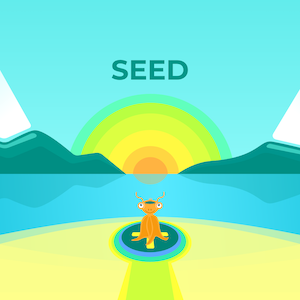
1982-2010
' the computer is the future '
A remark someone made in 1976. The same year that Kraftwerk from Dusseldorf, Germany released their album, Trans-European Express, and although the thought behind the statement was true, it would take a couple of decades to manifest itself. Technology would extend itself into creativity (almost like an evolutionary parasite) in a gradual, incremental way for millions of people across the world and for hundreds of different reasons. The story of electronic music and the advent of mass culture amplified by technology made a definitive impact on India in the new millennium, just like it did in Germany in 1970s; in the UK and US, and Japan in the 1980s, thereafter smashing its way from Rio to Beijing. The 70’s as a decade of experimentation in jazz and rock, witnessed the rise of a pioneering electronic music subculture via German bands like Kraftwerk, Tangerine Dreams and Can. Futuristic and sci-fi driven; inspiring a handful of composers across Europe and America, electronic sounds and tools became ‘ear friendly’ and ‘pop compatible’ for musicians and audiences. Electronic music eventually spilled over into mass appeal, post the Kraftwerk’s breakthrough album, Man-Machine released in 1978 (first German band/album to top British charts for six weeks) and Giorgio Moroder’s historic classic hit “I Feel Love” (selling 300,000 records in 1982). Why David Bowie, Nick Cage or Brian Eno exited the gloomy post punk Thatcherised England to seek newer grounds and sounds, is anybody’s guess. Electronic sound and instruments had finally come of age, and were now being viewed as harbingers of avant-garde music culture.
The Indian Spot
As early as 1982, Charanjit Singh (a synthesizer and guitar player working in leading Bollywood studios) recorded the album, Ten Ragas to Disco Beat; which remains the earliest recorded feature of Indian melodic ragas performed on synthesizers in sync with machine rhythms via the TR808 and 909. Though the album remains very obscure and minimal in terms of consumption and interest, the reappearance of this record, holds a great debate within. Charanjit Singh’s attempts as a composer are clearly contiguous to the rise of acid and techno music around the world. Unconnected and high in contrast to Charanjit’s album, were the smash hit Hindi-disco songs of the Pakistani siblings Nazia and Zoheb Hassan, produced by London-based Bangalore-born producer Biddu in 1983; who eventually became a Bollywood music director in the late ‘80s. Their single, “Disco Diwane” went on to become a long-standing hit in South Africa, and places as far away as Sao Paulo, Dhaka and Toronto. The crux of Indian listeners, audiences and composers would remain mostly unaffected by the surge of electronic music and technology much through the ‘80s; the real change was felt with the arrival of digital recording systems and synthesizers in Bollywood studios. Brilliant and almost obscure cult movies such as Om Dar Badar (directed by Kamal Swaroop) featured moody psychedelic mash- ups of electronic sounds, bass lines, drum machine beats and vocoders mixed with native voices and lyrics, composed by Rajat Dholakia (now a big commercial music producer in Mumbai). Nevertheless, electronic music flavours and the vast composition possibilities offered by synthesizers and samplers remained in the ‘safe hands’ of a few elite composers in India throughout the decade.
First Waves
The late 80’s in Goa saw the rise of tourism and a never-before felt intercourse between international cultures with the influx of the second wave of neo-hippies pouring out of the UK, US, Germany, Israel and France. Electronic music and sound arrived on Indian shores via DJs, writers, filmmakers and tourists from Europe. For close to three decades now, Goa has been a bustling, fertile zone for intercultural exchange; a place to party and escape urban pressures apart from a psychotropic and psychedelic haven teeming with nocturnal people. It is in this socio cultural melting pot that the popular, psychedelic electronic-music form, now known as ‘Goa trance’, was born. Goa trance met with an enthusiastic response from numerous young people who were jaded by Bollywood music and/or traditional forms of rock and pop. Nascent, chaotic and ‘psychotropic friendly’, this genre would eventually travel to and thrive in the far corners of Israel, Germany and Scandinavia. Goa trance eventually got absorbed and mutated into further progressive genres of psy, minimal and house music circa 1996. With an increasing number of DJs, self styled producers and record labels seeking newer audiences and markets in India and the world, the first wave of electronica had finally crashed on Indian shores.
Breakthrough
Electronica was curtailed to the Euro-centric rave culture in Goa and other hippie refuges around India until the mid-90s when, amongst the increasing musicians and bands who pushed the (indie, metal and Hindi) rock music scene, a few chose to break away from ‘traditional’ sounds, and dived straight into music technology. In tandem with these sporadic movements in India, Asian diasporas in the UK and US (Asian Dub Foundation, Nitin Sawhney, Talvin Singh, State of Bengal, Shiva Soundsystem, etc.) were attempting a fusion of underground electronica forms (breakbeats and drum & bass) layered with retro Bollywood, semi classical ragas and the tabla; all sequenced and mixed via turntables, samplers and synthesizers. The height of this cultural upheaval came in 1998 when Talvin Singh clinched the coveted Mercury Award, setting off an avalanche of reactions and opinions in international media and music circles. Asian DJs and producers were making their mark at nightclubs, local radio channels and indie record labels in London, New York and San Francisco. Though the potential of this outburst was never fully realised, with the propagators moving to more lucrative and popular environments, thousands of expat Indians and Asians came on to the dance floors. The Asian Underground movement became the voice of a generation that was wary of the subcontinent’s clichéd identity. Parallel to Asian-flavoured electronica being produced abroad, in India, the effort to fuse Indian voices, jazz ideologies, folk instruments, synthetic sounds and digital production platforms led to the transformation of musical taste in urban India. In 1998, Ram Sampath wrote and produced his only album, Colorblind, replete with dark, mature melodies produced on exciting electronic sound; and in the following year, Bombay Black Collective released compilation albums that remain among the most progressive attempts in Indian electronica. At the same time, MIDIval PunditZ emerged with their desi yet eclectic sound and went on to become one of the most-heard Indian electronica acts internationally. The Bhavishyavani order of DJs with their dose of groundbreaking drum & bass began getting dance friendly audiences off their feet in 1998 (and continue to do so till today). Meanwhile, psychedelic trance and progressive house was also growing heavier (and headier) as tribes of ravers moved to the mixes of DJ Ma Faiza, Asad and Who-Sane.
Empowered by technology
In a nation of one billion and counting, where music remains the traditional source of entertainment that’s not often seen as a field of progressive artistic endeavour, this ‘audio revolution’ of sorts, resulted in an electronica spillover that became a legitimate, alternate musical experience in big cities across India. Thanks to easy-to-use technology providing endless sonic possibilities and quality mixing options available across the world at affordable prices, Indian musicians and DJs found the window and acceptance in to night clubs, discotheques and eventually, bigger outdoor events. The spread of electronic music technology became progressively evident with the quantum rise in home studios, use of synthesizers, software and hi- fidelity mixing gadgets. The Roland MC303 - a trademark sequencer with ‘acid house’ sounds, that I acquired in 1998 (after endless mesmerizing hours of The Chemical Brothers and Propellerheads on my stereo), seems like a primitive, yet special toy in contrast to the universally acclaimed and amazingly progressive Ableton Live software; the byword in the musician/producer/DJ realms in India. Speaking of technology, perhaps the greatest revolution to have rocked the foundations of the music industry was the internet. Since the worldwide web explosion around 2000, the issues of piracy, free music sharing/downloading, distribution and exposure have challenged orthodox methods of music business. On the flip (brighter) side, the internet aided thousands of musicians in finding the space and speed to showcase and exchange music from across the world, eliciting instant reactions from fans and contemporaries. Indeed, the hardsell of music has been altered in the rising face of independent music distribution via online mechanisms like myspace, soundcloud, last.fm, bandcamp, etc. The presence of Indian musicians and electronica online in terms of events and marketing has fostered the much-needed awareness, and created space for information interchange, downloads, marketing and promotion. Emerging with greater confidence and diverse sensibilities, Indian electronic music artists like Jalebee Cartel, Teddy Boy Kill, Nucleya, Mental Martians, Kohra, Vinayaka, Tempo Tantrick, Dualist Enquiry, Shaa’ir + Func, Sulk Station, Pink Noise, Ganesha and Da Saz present a wide spectrum of musical influences and sonic results. Indian DJs have come of age too, delivering a plethora of styles ranging from house, minimal, drum & bass and breakbeats to swelling urban audiences. In recent years, cross-collaborations among DJs and musicians have become the new mode to deliver seamless live electronic music. Moreover, the constant cross-migration of various musicians of Asian-Indian origin from New York, San Francisco, London and Germany has created further inroads and solidarity in making Indian electronica a vested global movement. All artistic and culturally hip trends and groundbreaking voices emerge out of fringe subcultures around the world. Borne out of a need to break traditions and re-evaluate traditional ideologies of music and the arts, Indian electronica too, will be seen more legitimately as it grows in the near future.
This article was written & published in HUB - India's first anthology of electronic music and the people involved within this growing urban culture. Read more about HUB -http://audiopervert.blogspot.com/2011/06/june-15-2011.html
DOWNLOAD HUB - (Hi-rez PDF Format - Limited Edition 2011) http://www.mediafire.com/?ub2c4wqdn3kdd9t


























0 -